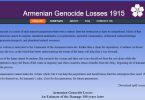Issue:[1] Can the Armenians as an indigenous people recover damages from the Republic of Turkey and private parties for violation of their rights to the use, maintenance and development of their aboriginal homeland, including natural and cultural patrimony?
- Overview
- Indigenous People’s Rights – growing importance, more precedents in national, regional and international fora.
- Armenians are an indigenous people.[2] There is no absolute standard under the United Nations Declaration on the Rights of Indigenous Peoples (UNDRIP); however, the Armenians meet all the criteria set out in the UNDRIP, and in addition, have been admitted to the UN Forum on Indigenous Peoples since the convention was adopted. Turkey, upon acceding to the UN Convention claimed there were no Indigenous Peoples in its territory. However, this self-serving denial of the rights of the indigenous peoples is not conclusive as a matter of international law. At international law, these rights belong to the indigenous peoples and they cannot be deprived of this by the bald political assertions of the states governments that violate those rights.
- Group remedies for group harm. As such it corresponds to the harm and issues as they are frequently articulated by Armenian survivors, in particular, claims as to loss of homeland, cultural heritage, natural patrimony, way of life.
- Distinct set of standards, rights and arguments from either criminal/crimes against humanity or civil/property claims, although many of the same facts. Although genocide and private property claims may be subsumed in indigenous rights claims, they do not necessary depend on or address such claims.
- Why focus on natural resources?
- Natural resources obvious components of the patrimony of the indigenous people in their ancestral lands.
- cultivation and prudent stewardship
- windfall, unjust enrichment.
- Largely future, public cash streams. Easier to reallocate, more directly addresses windfall, unjust enrichment. In addition to royalties, most of the profit in Turkey is going to state companies, which again is easier to reallocate than taking from private owners. This analysis does not address the value of the already depleted natural resources and the lost benefit to the Armenian nation, which is more problematic to recover, since it would involve clawing back or repaying funds already expended and disbursed.
- The mineral wealth of Armenia was well known and coveted by the Ottomans and European powers. The current value of the natural resource wealth of Armenia’s aboriginal lands currently controlled by the Republic of Turkish for future exploitation is estimated to be in excess of $1.5 trillion. (armeniangenocidelosses.am)
- Natural resources obvious components of the patrimony of the indigenous people in their ancestral lands.
- Substantive Rights, Sources of Law
- What rights do indigenous peoples have with respect to their aboriginal homeland?
- Way of life
- Cultural heritage
- Natural resources
- Environmental – safety, habitat protection
- Special duty of the sovereign to the group – trust, protected minority, over and above state’s duties toward citizens qua From bilateral and multilateral treaties, e.g., Kuchuk Kainarji (1774, Art. 7), Treaty of Berlin (1878, Art. 61, 62), Treaty of Lausanne (1923, Art. 37-43 for continuing violation claims).
- Multilateral International Declarations and Conventions – Peace treaties with minority rights protections, boundary and other settlement mechanisms, indirect impact on Armenians
- The United Nations Declaration on the Rights of Indigenous Peoples (UNDRIP) adopted by the General Assembly on Thursday, 13 September 2007, 144 in favor, 4 against (US, Canada, Australia, and New Zealand), 11 abstentions (including the Russian Federation, Azerbaijan, Ukraine and Georgia). Turkey voted for the Declaration, as it is not among the abstentions.
- ILO Convention on Indigenous and Tribal Peoples 1989 (no. 169), currently ratified by 22 countries, not including Turkey or Armenia.
- What rights do indigenous peoples have with respect to their aboriginal homeland?
- Examples of Natural Resources on Armenian Aboriginal Lands
- Adiyaman Oil Field – no. of Urfa, part of Armenia’s Versailles 1919 claim. 27% of Turkey’s production. TPCO 72 million barrels reserve (even at $30/barrel $2 billion).
- Afsin Coal Field – Marash, no. of Zeytun, 40% of the coal production in Turkey.
- Aladag – Adana, chromium mine, owned by Eti Maden, (Parent – Savings Deposit Insurance Fund of Turkey) has a reserve 200 million tonnes,
- Batman oil field southeast of Dikranagerd, owned by the Turkish Petroleum Corporation. 8.9 million barrels of crude oil and 10.6 million sm3 natural gas were produced in 2014. It accounts for more than 50% of Turkey’s oil production.
- Cayeli Bakır İşletmeleri, Çayeli Copper, Zinc mine on the Black Sea Coast, near Trebizond in Rize, considered as an outlet to the sea for Armenia during the Paris Peace Conference post-WWI. 1.2 million tonnes, annual production; Inmet Mining Corporation (Canada) and First Quantum Minerals Ltd (Canada). One of Turkey’s largest companies traded on the Toronto Stock Exchange.
- Cevizlidere, Copper mine, in Tunceli, 445 million tones in reserves, north of Elazig, south of Erzincan. One of the largest copper mines in Turkey. In the north of Mamuretulaziz, part of Dersim region, not far from Chemishgezek. Owned by Alacer Gold Corporation (USA).
- Mollakara, Gold Mine, north of Van, in Aghbi, Agri Province, operated by, KOZA ALTIN İŞLETMELERİ A.Ş. Total Proven and Probable Reserve 59,954 kilotonnes of ore.
- Murgul, copper mine, owned by Eti Maden IGM, a Turkish state-owned mining and chemicals company, (parent – Savings Deposit Insurance Fund of Turkey), in Ardvin, located 30 km from the Black Sea, part of Russian Armenian Provinces until WWI, has 40 million tonnes of copper ore (reserve), one of the largest copper mines in Turkey.
- Çakmakkaya, Copper mine, owned by, Eti Maden, Parent – Savings Deposit Insurance Fund of Turkey, in Ardvin, one of the largest copper reserves in Turkey, with over 800,000 tonnes of copper.
- Damar, Copper mine, owned by Eti Maden (Parent – Savings Deposit Insurance Fund of Turkey) in Ardvin, 167,000 tonnes of copper metal.
- Avnik, Iron mine, owned by Eti Maden (Parent – Savings Deposit Insurance Fund of Turkey) the largest iron reserve in Turkey with estimated reserves of 43.7 million tonnes of iron metal, located in Bingöl
- Diyarbakır oil field, owned and developed in 2009 by Turkish Petroleum Company, has proven reserves of 16 million barrels, with production of 250K barrels a day.
- Çöpler Gold, owned by Alacer Gold, with estimated reserves of 6 million oz. of gold, located south-west of Erzincan, (Armenian Երզնկա Yerznka),
- Hasancelebi, Iron, owned by Eti Maden (Parent – Savings Deposit Insurance Fund of Turkey), as the largest iron reserve in Turkey, with more than 10.8 million tonnes of iron metal, located in Malatya Province.
- Mardin, Phosphate mine, owed by Eti Maden (Parent – Savings Deposit Insurance Fund of Turkey), in Mardin, southeast Turkey, one of the largest phosphate reserves in Turkey, with over 200 million tonnes of ore.
- Coal – 40% of Turkey’s reserves in Albistan – Marash/Zeytun
- Precedents, Claims, Parties, Trends
- Types of claims
- Disruption of way of life due to relocation, displacement, natural resource development
- Rights to benefit from exploitation of national patrimony, e.g., natural resources, share in royalties, right to decide whether and how to develop/benefit from natural resources on aboriginal lands, process rights
- Compensation for degradation or deprivation of land, property, cultural heritage
- Defendants
- State – as producer, investor, regulator, trustee
- Private actors – as producer, investor, seller, broker
- Secondary private actors – third-party beneficiaries – buyers – how far down the economic chain?
- Claimants
- Decolonialized states
- Recognized stateless peoples within the territory
- Exiled nation/peoples on reservations
- Growing number of precedents righting historical and contemporary wrongs to indigenous peoples and application of decisions from American and African forums in Europe.[3]
- Examples/Case Studies – Cases are factually unique as they arise in very different historical and legal contexts. Nevertheless, they do provide precedent for the proposition that indigenous peoples have a right to benefit from the natural resources in their aboriginal lands, whether or not they have current title to the surface rights where the natural resources are located.
- Australia – Nauru[4] (James Crawford, Ian Brownlie). ICJ – concluded in a negotiated settlement, after the Nauru claim survived a motion to dismiss. A key element was the Mandatory Trustee’s duty to act in the interests of the indigenous people and take depletion of resources into account in its management of the aboriginal mineral resources, which had not been done in this instance.
- Doğan and Others v. Turkey, No. 8803/02 [2004] ECHR 296 (29 June 2004) (deprivation of access to property violation of Article 1 of Protocol No. 1 to the ECHR, even without current title or possession, if deprivation of economic interest, including “unchallenged rights over the common lands in the village”).
- United States. Cobell v. Salazar, $3.4 bn. Settlement, mismanagement of trust. 2 bn. For repurchase and restoration of land to the tribe. (largest class action in US history).
- United States. Native Americans – Indian Claims Commission established in 1946 eventually awarded over by 1978 – $818,172,606.64
- The Mayagna (Sumo) Awas Tingni v Nicaragua, (2001), paras. 140(b) and 151. IACtHR Inter-American Court, which integrates ancestral indigenous tenure into property law for the purposes of the American Convention on Human Rights
- Suriname – Saramaka People v. Suriname (28 November 2007) Inter-Am. Ct. H.R. (Ser. C) No. 172 at §§93–96. (Aboriginal title upheld on international law grounds despite no basis in domestic law).
- South Africa the held that the Community’s historic ownership interest included communal ownership of the materials and precious stones, including diamond mine.
- Kenya – Kenya – African Human Rights Commission Condemns Expulsion of Endorois, Feb. 4, 2010 (HRW report) African Commission found against Kenya – ordered (a) Restitution of their land, with legal title and clear demarcation. (b) Compensation to the community for all the loss they have suffered through the loss of their property, development and natural resources, but also freedom to practice their religion and culture.
- Nigeria – The Social and Economic Rights Action Centre for Economic and Social Rights v. Nigeria’, (the Ogoni Case) upholding right of ‘peoples to retain rights as peoples,’ that is, as collectives. African Commission on Human and Peoples’ Rights, Comm. No. 155/96, (2001), para. 40.
- Amodu Tijani v. Southern Nigeria, United Kingdom Privy Council, 2 AC 399, (1921). – “The title, such as it is may not be that of the individual, as in this country it nearly always is in some form, but may be that of a community. Such a community may have the possessory title to the common enjoyment of a usufruct, with customs under which its individual members are admitted to enjoyment, and even to a right of transmitting the individual enjoyment as members by assignment inter vivos or by succession.”
- Philippines – One of the more progressive legislative frameworks is the Philippines Mining Act (1995), which has gone a long way toward harmonize national laws with the UNDRIP and the ILO, 169, in furtherance of its constitutional protection of indigenous peoples rights. Query: Possible model for negotiated settlement with Turkey on the Armenian indigenous people’s claims, since like the Philippines, Turkey considers all mineral resources to be owned by the State.
- Philippines Constitution (1987) Article XII, Section 5: “The State, subject to the provisions of this Constitution and national development policies and programs, shall protect the rights of indigenous cultural communities to their ancestral lands to ensure their economic, social, and cultural well-being. The Congress may provide for the applicability of customary laws governing property rights or relations in determining the ownership and extent of ancestral domain.”
- Philippines Mining Law (1995) Section 4: “Mineral resources are owned by the State and the exploration, development, utilization, and processing there of shall be under its full control and supervision. The State may directly undertake such activities or it may enter into mineral agreements with contractors.”
- Section 16: “No ancestral land shall be opened for mining operations without the prior consent of the indigenous cultural community concerned.”
- Section 17. Royalty Payments for Indigenous Cultural Communities. – “In the event of an agreement with an indigenous cultural community pursuant to the preceding section, the royalty payment, upon utilization of the minerals shall be agreed upon by the parties. The said royalty shall form part of a trust fund for the socio-economic well-being of the indigenous cultural community.”
- The Turkish Constitution does not have these, but the Armenian Constitutions (1995, 2005) have minority protection rights and 2015 Armenian Constitution, Art. 29 and 31, has them, even more explicitly, but not specific to natural resources.
- Types of claims
- Strategic Considerations
- Choice of Forum – Litigation vs. Other International Forums
- What forum presents the best chance of surviving a motion to dismiss or political deadend?
- Credible risk of adverse ruling for defendants, cascading precedent against other potential defendants?
- Enough to get the parties to the negotiation table for a settlement on the merits
- Kind of proceedings – closed-ended vs. open-ended process
- Choice of Forum – Litigation vs. Other International Forums
- closed-ended – judicial/quasi-judicial – contentious, arbitration, negotiated settlement, international administrative (investigation with enforcement mechanism)
- Special Rapporteur on the Rights of Indigenous Peoples
- Council of Europe, Advisory Committee on the Framework Convention for the Protection of National Minorities
- open-ended – political resolution, negotiations, truth commissions, etc.
- UN Permanent Forum on Indigenous Issues
- Pursue private claims first
- Church property – Armenian community of the faithful or national property in the trust of the church? Is the church really free to dispose of property or claims without accountability to the nation? What about church property in the protection of one or another state?
- Other titled property, or identifiable movable property
- Inventory Natural and Cultural Patrimony on aboriginal lands
- document Armenian rights to these lands – ethnic settlements (Armenian towns & villages and auxiliary lands),
- map against current known natural resources on aboriginal lands
- determine owners/beneficiaries – claims against state for illegal licensing, claims against current users to desist (if incompatible with cultural heritage protection) or share profits with indigenous peoples.
- consider indigenous co-claimants, e.g., Kurds, Assyrians, Crypto-Armenians, Greeks
- consider negotiated policy solutions, like the ILO/UNDRIP-compliant Philippines natural resources framework as a model.
- Pursue private claims first
Selected Bibliography
Anaya, S. James, Indigenous Peoples in International Law, 44 (1996).
Anaya, S. James, The Capacity of International Law to Advance Ethnic or Nationality Rights, Human Rights Quarterly, Johns Hopkins University Press, Vol. 13, No. 3 (Aug., 1991).
Armenian Genocide Losses. http://armeniangenocidelosses.am/
Armenian Church Losses during the Genocide https://www.arak29.org/duringgenocide/index.php
Australia-Republic of Nauru: Settlement of the Case in the International Court of Justice Concerning Certain Phosphate Lands in Nauru, Aug. 10, 1993, 32 I.L.M. 1471 (Nov. 1993).
Barkan, Elazar, The Guilt of Nations: Restitution and Negotiating Historical Injustices: Restitution and Negotiating Historical Injustice. (Norton, 2000).
Basic Principles and Guidelines on the Right to a Remedy and Reparation for Victims of Gross Violations of International Human Rights Law and Serious Violations of International Humanitarian Law, G.A. Res. 60/147, Principle 18, U.N. Doc. A/RES/60/147 (Dec. 16, 2005).
Bassiouni, M. Cherif, International Recognition of Victims Right, 6 Hum. Rts. L. Rev. 203, (2006).
Cambou Dorothee and Smis Stefaan, Permanent Sovereignty over Natural Resources from a Human Rights Perspective: Natural Resources Exploitation and Indigenous Peoples’ Rights in the Arctic, Michigan State International Law Review, Vol. 22:1, (2013).
Case Concerning Certain Phosphate Lands in Nauru (Nauru v. Australia) (Preliminary Objections, Judgment), 1992 I.C.J. 240 (June 26).
Cernic, Letnar Jernej, State Obligations Concerning Indigenous Peoples’ Rights to Their Ancestral Lands: Lex Imperfecta? Am. U. Int’l L. Rev. (2013).
Chagos Islanders v. The United Kingdom, App No. 35622/04, Eur. Ct. H.R. (2012)
Crawford, James R., The Rights of Peoples (Clarendon, 1992).
Elias, T. O., The Doctrine of Intertemporal Law, The American Journal of International Law, Vol. 74, No. 2 (Apr., 1980),
Geer, A. Martin, Foreigners in the Their Own Land: Cultural Land and Transnational Corporations – Emergent International Rights and Wrongs, 38 Va. J. Int’l L. 331 (1997-1998).
Gilbert, Jeremie, Historical Indigenous Peoples’ Land Claims: A Comparative and International Approach to the Common Law Doctrine on Indigenous Title, The International and Comparative Law Quarterly, Vol. 56, No. 3 (Jul., 2007).
Gilberthorpe, Emma; Hilson, Gavin, eds., Natural Resource Extraction and Indigenous Livelihoods: Development Challenges in an Era of Globalization (Surrey: Ashgate, 2014).
Holley, Michael, Recognizing the Rights of Indigenous People to their Traditional Lands: A Case Study of an Internally-Displaced Community in Guatemala, 15 Berkeley J. Int’l L. 119 (1997).
Horvath, J. Roland, A Definition of Colonialism, The University of Chicago Press, Vol. 13, No.1. (Feb., 1972).
Indigenous and Tribal Peoples’ Rights over Their Ancestral Lands and Natural Resources, Norms and Jurisprudence of the Inter-American Human Rights System, http://www.oas.org/en/iachr/indigenous/docs/pdf/ancestrallands.pdf
Kingsbury Benedict, Reconciling Five Competing Conceptual Structures of Indigenous Peoples’ Claims in International and Comparative Law, International Law and Politics, Vol. 34:189.
Lippe, John M. Vander, The “Other” Treaty of Lausanne: The American Public and Official Debate on Turkish-American Relations, The Turkish Yearbook, Vol. XXIII (1993), pp. 31-62.
McFadden, M. Patrick, The Right to Stay, 29 Vand. J. Transnat’l L. 1, 22-24 (1996).
Meyer, H. Lukas, Reparations and Symbolic Restitution, Journal of Social Philosophy, Vol. 37 No. 3, (Fall 2006).
Mining Interests in Asia Minor 1920-21 (Arghana copper mine in France), http://www.helleniccomserve.com/pdf/mininginterestinasiaminor.pdf .
Miranda, Aponte Lillian, Indigenous Peoples as International Lawmakers, U. Pa. J.Int’l L. Vol. 32:1, 2010.
Otis, Ghislain and Laurent, Aurélie, Indigenous land claims in Europe: The European Court of Human Rights and the decolonization of property, Arctic Review on Law and Politics, vol. 4, 2/2013.
Painemilla, Walker Kristen; Rylands, B. Anthony, Indigenous Peoples and Conservation, From Rights to Resource Management, Conservation International (2011).
Paust, Jordan, Human Rights through the ATS After Kiobel: Partial Extraterritoriality, Misconceptions, And Elusive And Problematic Judicially-Created Criteria, Duke Forum For Law & Social Change Vol. 6:31 2014.
Reyes, Ramon E. Jr., Nauru v. Australia: The International Fiduciary Duty and the Settlement of Nauru’s Claims for Rehabilitation of Its Phosphate Lands, 16 N.Y.L. Sch. J. Int’l & Comp. L. 1 (1996).
Roht-Arriaza, Naomi, pp. 121-139 in Stover, Eric & Weinstein, Harvey M., My Neighbor, My Enemy: Justice and Community in the Aftermath of Mass Atrocity (Cambridge UP, 2004).
Roht-Arriaza Naomi, Reparations in the aftermath of Repression and Mass Violence.
Shaunnagh, Dorsett, Lee, Godden A Guide to Overseas Precedents of Relevance to Native Title, 1998.
Skogvang, Funderud Susann, Legal Questions Regarding Mineral Exploration and Exploitation Indigenous Areas, Michigan State International Law Review (2013).
Stavropoulou, Maria, The Right Not to be Displaced, 9 Am. U.J. Int’l L. & Pol’y 689, 693 (1994).
Strauch, Laurie Weiss and Panlilio William B., Defending against Alien Tort Statute Cases Post-Kiobel: What are the Key Defenses? The American Law Institute, June 12, 2013.
Steinhardt, Ralph, The ATS After Kiobel, (January 31, 2014).
Susskind, E. Lawrence and Anguelovski, Isabelle, Addressing the Land Claims of Indigenous Peoples, MIT (2008).
The United Nations Declaration on the Rights of Indigenous Peoples, A Manual for National Human Rights Institutions, APF, United Nations Human Rights Office of High Commissioner (2013).
The United Nations Principles of on Business and human Rights, United Nations Human Rights Office of High Commissioner (2011).
Thio, Li-Ann, Managing Babel: The International Legal Protection of Minorities in the Twentieth Century, (Martinus Nijhoff March 2005).
United Nations, The Concept of Indigenous Peoples, Workshop on Data Collection and Disaggregation for Indigenous Peoples (New York, 19-21 January 2004).
White Face, Charmaine; Wobaga, Zumila, Indigenous Nations’ Rights in the Balance: An Analysis of the Declaration on the Rights of Indigenous Peoples, (St. Paul, MN: Living Justice Press, 2013)
Vine, David; Philip Harvey, and S. Wojciech Sokolowski, Compensating a People for the Loss of Their Homeland: Diego Garcia, the Chagossians, and the Human Rights Standards Damages Model, 11 Nw. J. Int’l Hum. Rts. 152 (2012)
Ward, Tara, The Right to Free, Prior, and Informed Consent: Indigenous Peoples’ Participation Rights within International Law, 10 Nw.J. Int’lHum.Rts.54 (2011).
Turkey Natural Resources, Mining and Land Law
Akçam, Taner; Kurt, Umit, The Spirit of the Laws: The Plunder of Weather in the Armenian Genocide, NY: Berghahn, 2015)
Arseven, Benan; Ersin, Burcu Tuzcu, Overview of Mining in Turkey (2015)
Baghdjian, Kévork K. La confiscation, par le gouvernement turc, des biens arméniens–dits abandonnés” (Montréal: K.K. Baghdjian, 1987)
Barnes, J. R, An Introduction to Religious Foundations in the Ottoman Empire (Leyden: Brill 1987), 184p.
Ergil, Doğu, Turkish Reform Movement and Beyond (1923—1938), Islamic Studies, vol. 14, no. 4 (Winter 1975), pp. 249-260.
Ergil, Doğu, Development of Turkish Semi-Colonialism, Islamic Studies, vol. 18, no. 3 (Autumn 1979), pp. 183-229
Ertuǧ, Füsun, Linseed Oil and Oil Mills in Central Turkey Flax/Linum and Eruca, Important Oil Plants of Anatolia, Anatolian Studies, vol. 50 (2000), pp. 171-185.
Karajian, Hakob, Mineral Resources of Armenian and Anatolia, (New York, 1920).
Karajian, Hakob, Mines of Armenia in Asia Minor and Cilicia (New York 1919) (in Armenian) (Հանքեր Հայաստանի, Փոքր Ասիոյ եւ Կիլիկիոյ)
Kévorkian, Raymond H., National assets and properties of the Armenians in the Ottoman Empire: spoliation and destruction;
Levinthal, Louis E., The Land Laws of Turkey, American Bar Association Journal, vol. 2, no. 2 (Apr. 1916), pp. 182-201
Minkov, Anton, Ottoman Tapu Title Deeds in the Eighteenth and Nineteenth Centuries: Origin, Typology and Diplomatics, Islamic Law and Society, vol. 7, no. 1 (2000), pp. 65-101
Ongley, F., trans. Ottoman Land Code (trans. into English) (London, 1892) (mines Sec. 107).
Polatel, Mehmet, A History of Destruction: The Fate of Armenian Church Properties in Adana, Armenian Weekly, (October 14, 2011).
Tok, Alaaddin, The Ottoman Mining Sector In The Age Of Capitalism: An Analysis Of State-Capital Relations (1850-1908), Boğaziçi University 2010.
Üngör, Uğur Ümit, Polatel, Mehmet, Confiscation and Destruction: The Young Turk Seizure of Armenian Property London/New York: Continuum, 2011).
[1] Outline prepared by team led by Tom Samuelian. Contributing researchers: Carla Gharibian, Alan Grigorian, Hayk Mamajanyan, Hovhannes Asryan, David Davidian (2016, updated Dec. 22, 2021).
[2] United Nations Permanent Forum on Indigenous Issues, Who are Indigenous People: Factsheet, http://www.un.org/esa/socdev/unpfii/documents/5session_factsheet1.pdf. The Indigenous People of Eastern Anatolia: Armenians and their Rights over their Ancestral Homeland and Natural Resources, The Armenian Yearbook of International and Comparative Law, Vol. 2 (2017) “Professor Duffy, in her article, Indigenous Peoples’ Land Rights: Developing a Sui Generis Approach to Ownership and Restitution, 15 Int’l. J. Minority Groups & Rights 505, 507 (2008) identified four common elements present in international law definitions of indigenous people. First, indigenous people are the original inhabitants and maintain a special connection to territories forcibly subjugated by foreign powers. Second, indigenous people self-identify themselves as distinct from other, neighboring, societies. Third, they differ substantially from the dominant culture in control of the same territories. Last, indigenous people preserve their culture and connection to their ancestral lands under the domination of external forces. In the context of Professor Aoife Duffy’s guidelines, Armenians satisfy all four criteria and hence can be considered indigenous to Eastern Anatolia.”
[3] Otis, Ghislain and Laurent, Aurélie, Indigenous land claims in Europe: The European Court of Human Rights and the decolonization of property, Arctic Review on Law and Politics, vol. 4, 2/2013.
[4] The Mandate System, which was the first of its kind, reinforced the general principle that control of a territory is separate and distinct from the issue of ownership of the territory’s economic assets. The trustee was “precluded from administering the property for his own personal benefit.” (Reyes, 16)







